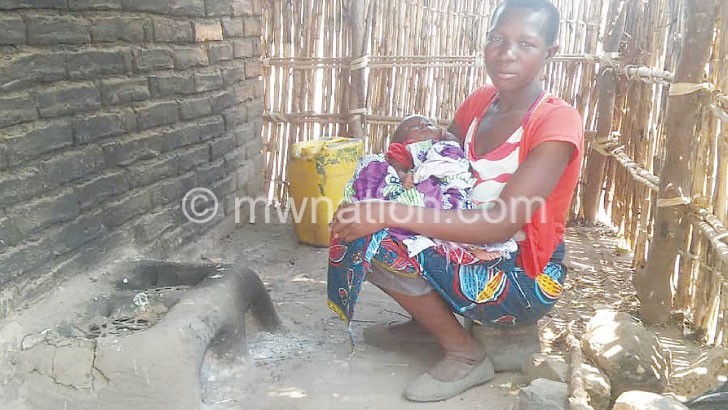No fire, no flour, no food
The mid-day sunshine is blazing in group village head (GVH) Alumando in Chikwawa. It is lunchtime, but many residents are not eating. They are not fasting either.
“We have nothing to eat. Nothing really,” says Mirriam Mponya, 23.
Seated under trees and on verandas, the locals, including children, anxiously stare into the space, waiting for an unlikely miracle. Under normal circumstances, plates of nsima, the staple food made from maize flour, would be seen in their midst.

Mponya is sitting on a kitchen stool, with a baby on her lap. She looks frail and gloomy, like her baby. Both are hit hard by the pangs of hunger. She has not eaten anything since the previous night when she had porridge from a one-kilogramme (kg) ration. In her fireplace, the ashes from the previous-night’s cooking confirm that no fire was lit today.
“There is no flour in my food basket. I have no money too. I don’t know where to get some,” says Mponya, calming the crying baby caringly.
The child needs to suckle, but she cannot breastfeed her. No milk is coming out, she says.
Her husband, Arnold Mponya, 28, is helplessly leaning against a chitimbe tree, a yard from the kitchen. He watches his wife and the baby sympathetically.
“Due to drought, I harvested almost nothing last growing season. I do piecework to get money to buy food, but the small jobs have disappeared,” says the desperate breadwinner.
Last year, Mponya planted maize at the onset of the rainy season. He bought four bags of fertilisers at K80 000, but no sooner had the maize tasseled than prolonged dry spells in December left the food crop wilting and drying.
In September, the Malawi Vulnerability Assessment Committee (Mvac) reported that at least 3.3 million Malawians face hunger due to poor maize yield. The committee attributes the looming food crisis to extended dry spells and an infestation of fall armyworms in almost all districts.
According to the United Nation’s Food and Agricultural Organisation (FAO), farmers in the country yielded 3 million metric tonnes of maize, a 15 percent drop from the 2017 harvest.
The Ministry of Agriculture, Irrigation and Water Development reports that the country has recorded a 22.1 percent drop in Maize production this year.
The low yield means that many families are struggling to have meals as most of them exhausted their meagre yield as early as June. Now the situation is getting leaner as the new rainy season begins.
Mponya and her neighbours in Chikwawa have been surviving on nsima made of sorghum and millet flour.
“Only occasionally, when one gets some piecework, do we buy maize. Most of us can only afford no more than five kilogrammes,” says Martin Nelson, from Kabotolo Village in Traditional Authority (T/A) Ndakwera.
As hunger and poverty worsens, the hand-to-mouth lifestyle has prompted chief Ndakwera to sound an SOS for relief food. He says the dry spells affected his area the most.
“We want some free and affordable maize to be dispatched soon. Otherwise, we won’t live to see tomorrow,” he pleads.
Joining Ndakwera is Sub-Traditional Authority (ST/A) Tsikulamowa from Ntcheu District who says her subjects are also facing hunger.
“No one harvested anything this year in my area. The drought was just too severe for us,” she says.
Away from Chikwawa and Ntcheu districts some households in T/A Nazombe, Phalombe, have been surviving on pigeon peas and dry cassava tubers.
“Nandolo from the previous growing season has saved my family since March,” says Ekari Mwitha, a mother of five, who failed to sell the commodity due to low market prices.
Similarly, some communities from Balaka, Blantyre and Chiradzulu districts have been equally desperate for food relief since March, when they harvested too little to take them to the next harvest.
“We are lucky mangoes are in season. We will be boiling them for supper every night,” explains Rajabu Kayaye, from T/A Kalembo, Balaka.
According to Mvac, the country needs to raise about K20.8 billion to buy 138 488 metric tonnes of maize to feed 3.3 million people facing hunger until the next harvest in March 2019.
Maize distribution has started in some districts, including Mchinji where 3 000 households are food insecure. Phalombe is another district where maize distribution is underway. In Blantyre, the district commissioner Bennet Nkasala said there were plans to reach out to households with relief food.
The Department of Disaster Management Affairs (Dodma) launched the distribution exercise to help out the population facing hunger this year.
As for Mponya and his wife in Chikwawa, they are waiting for their turn-not knowing what tomorrow brings.





